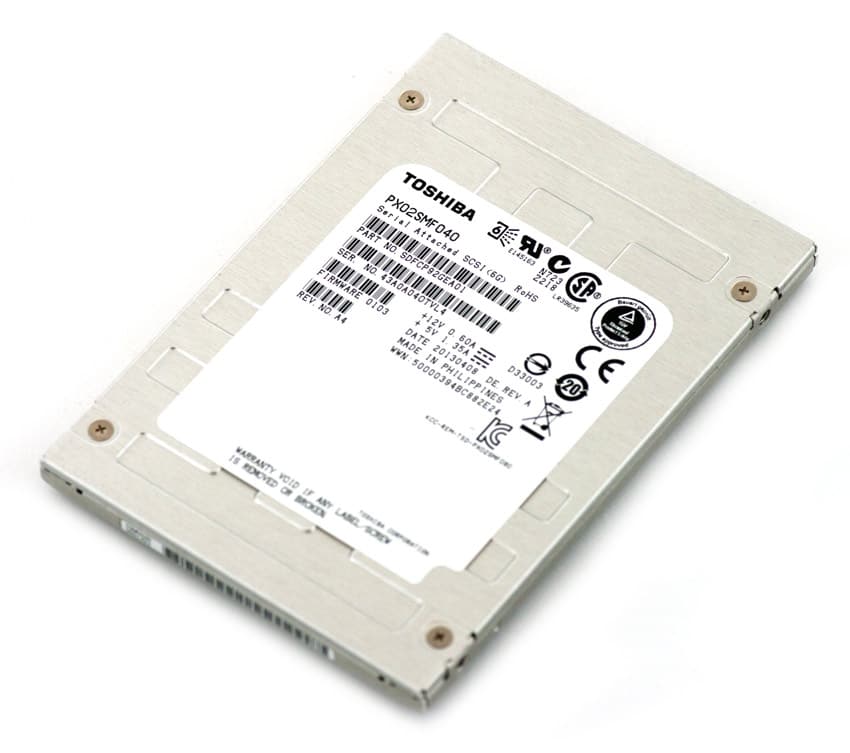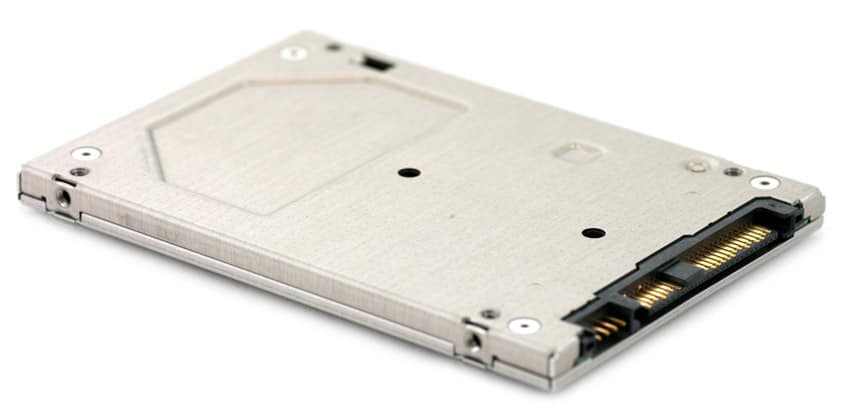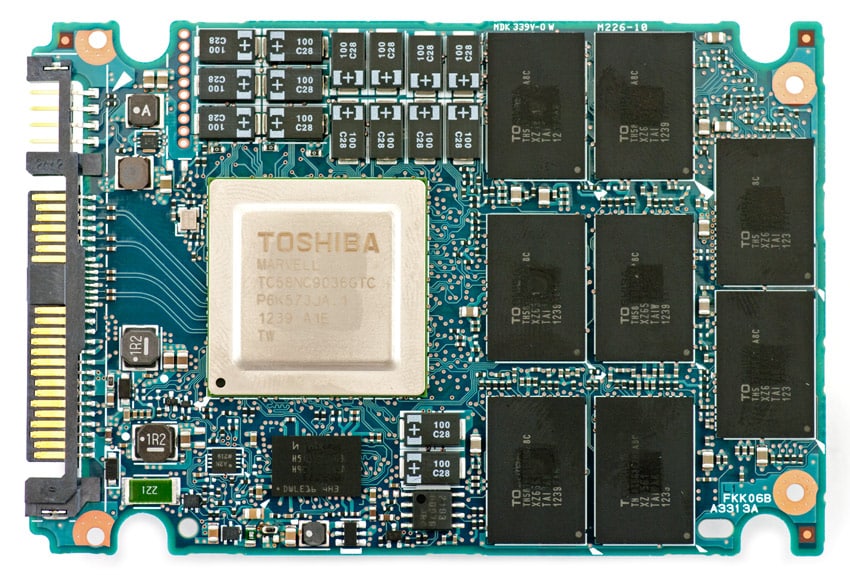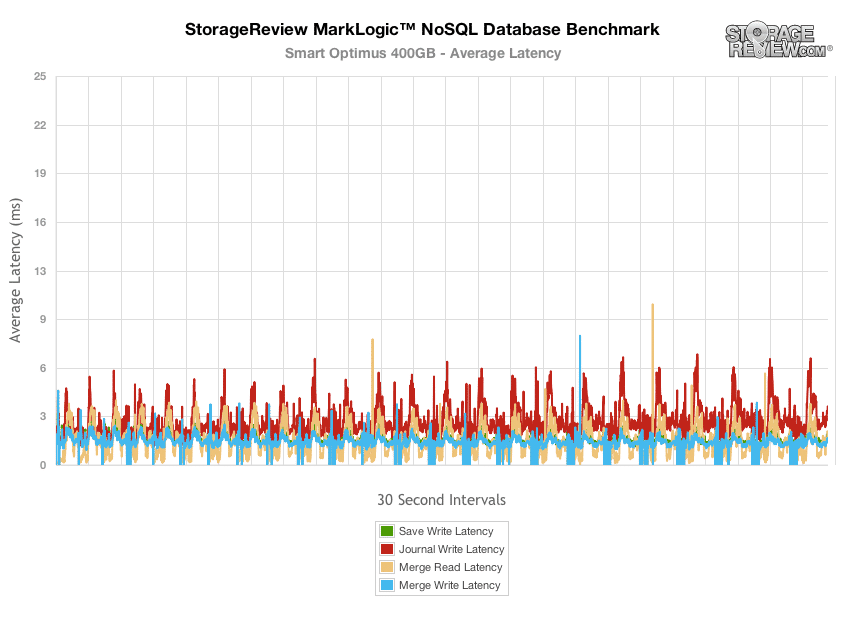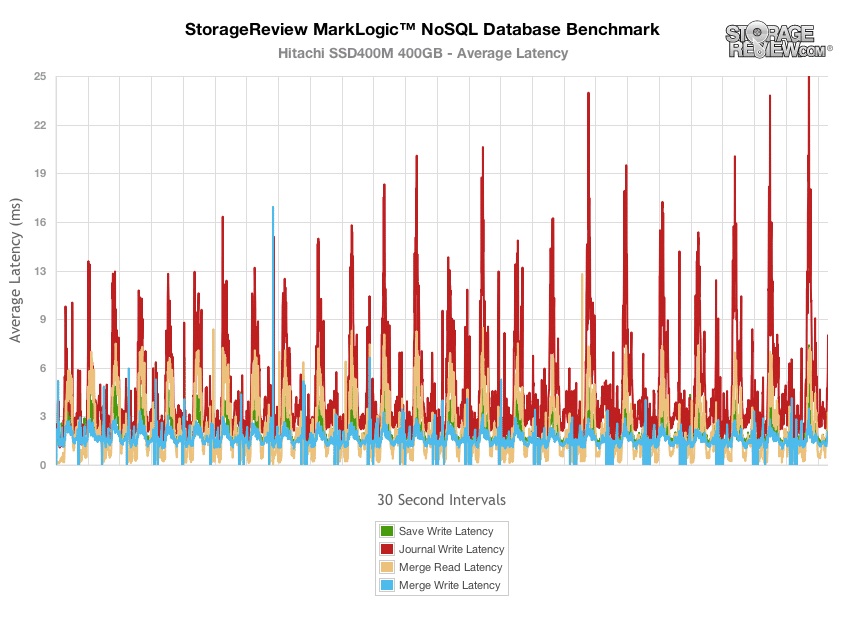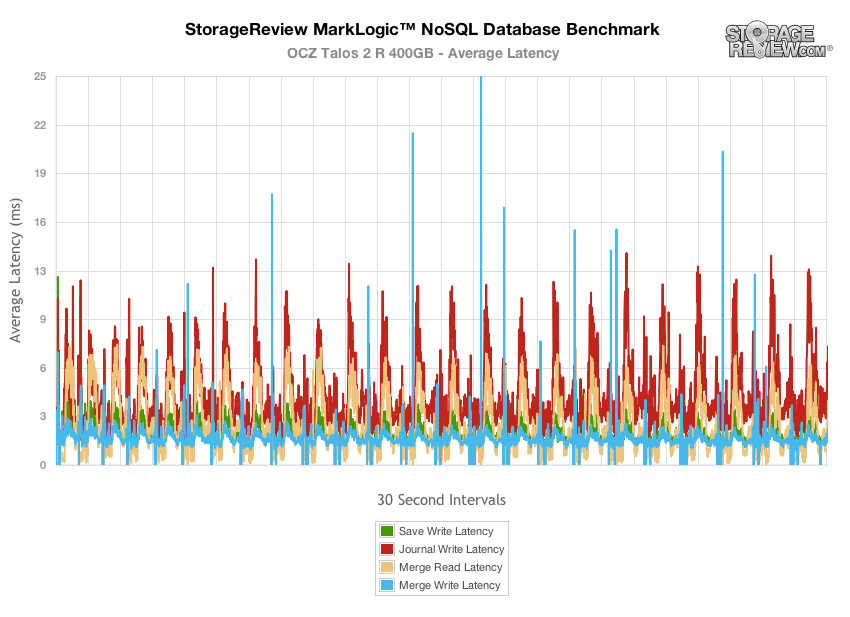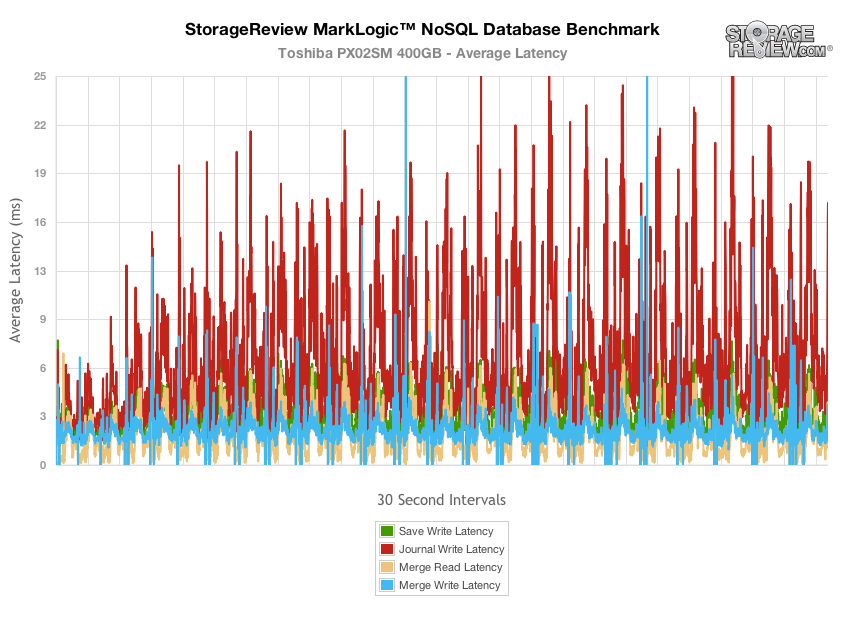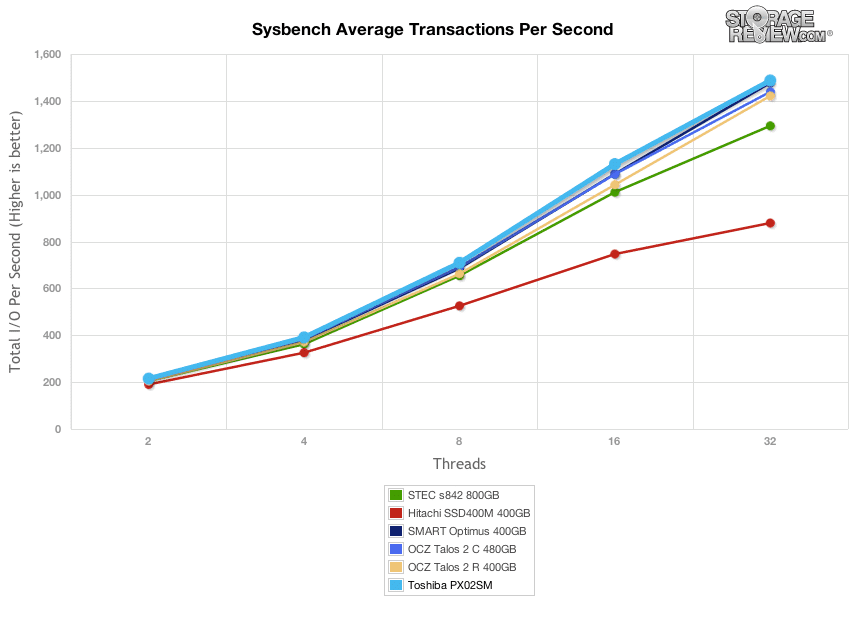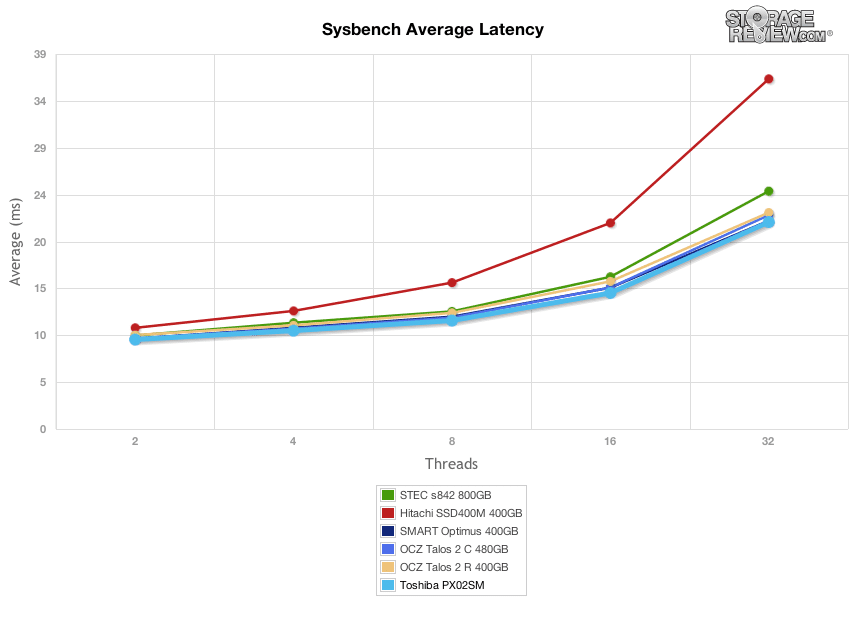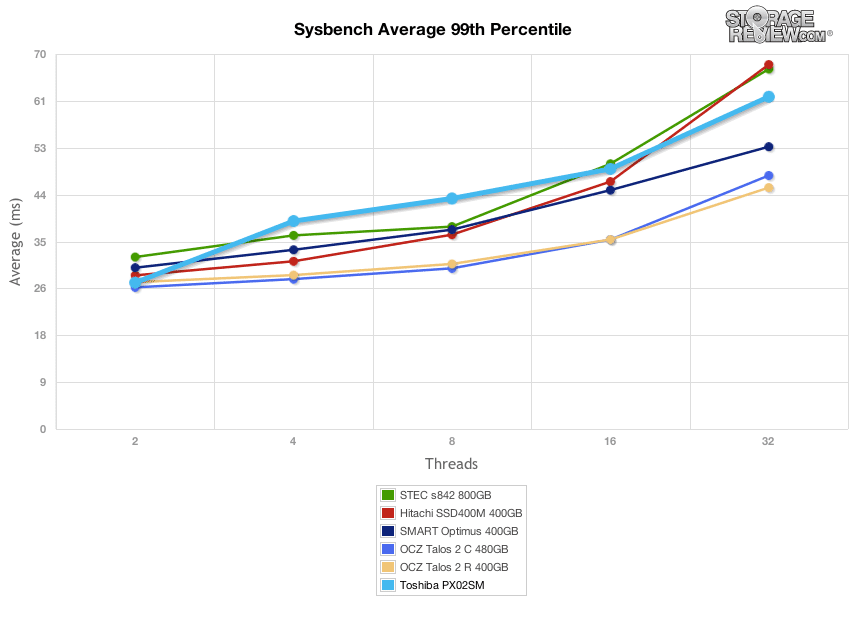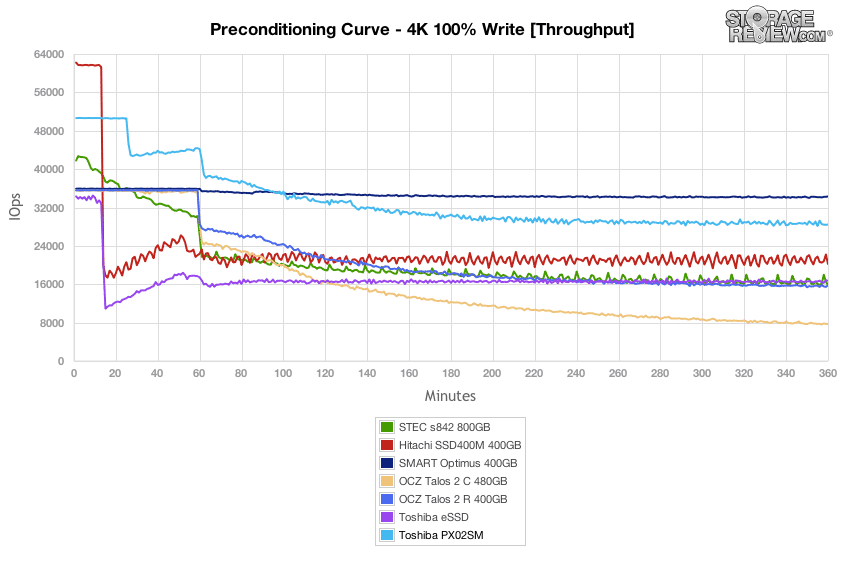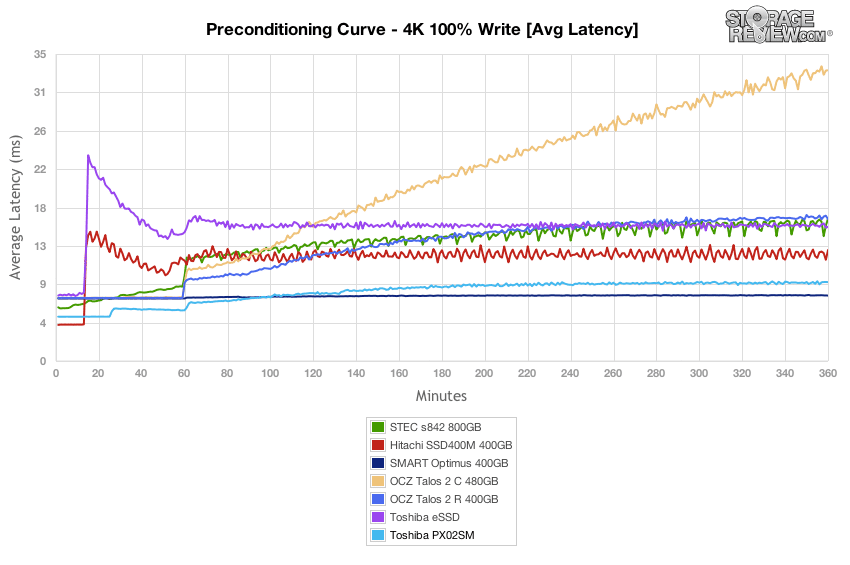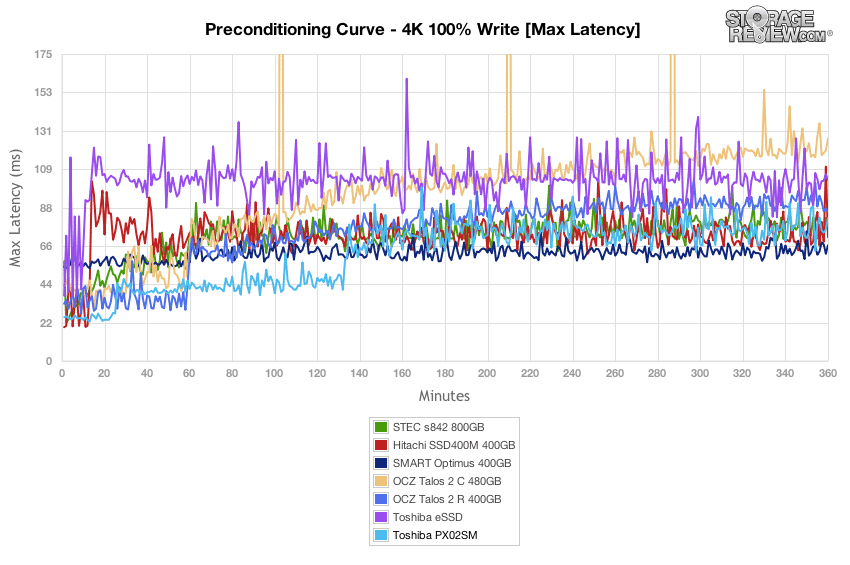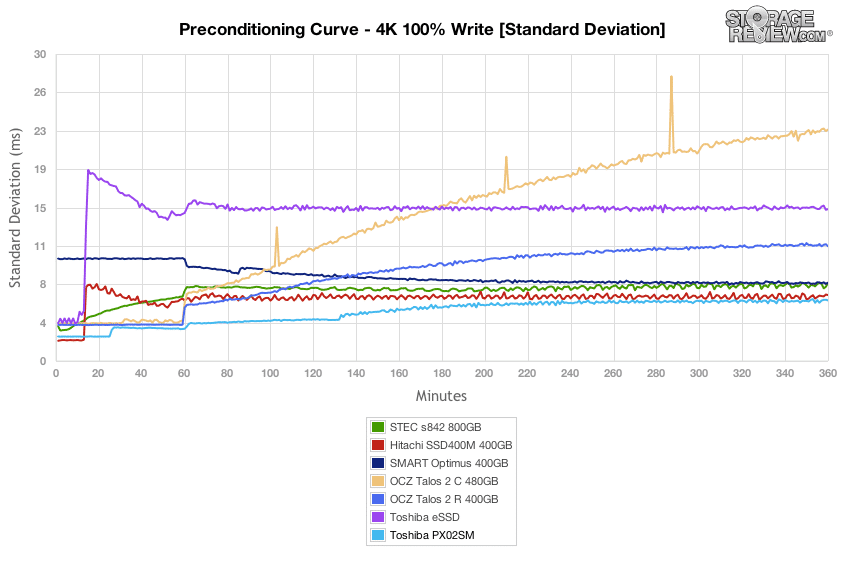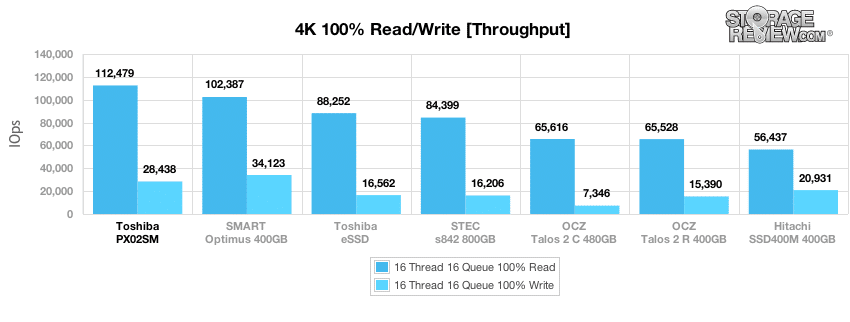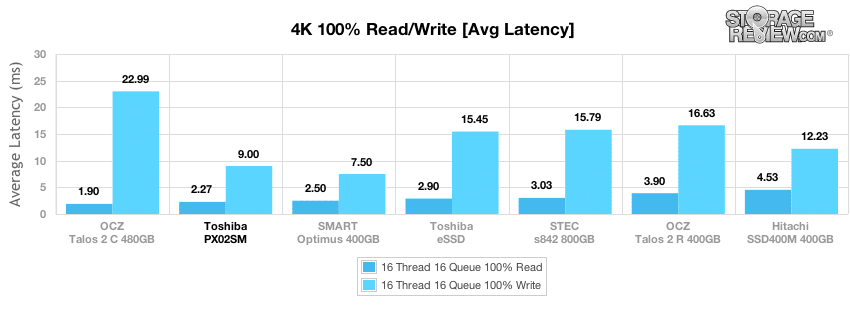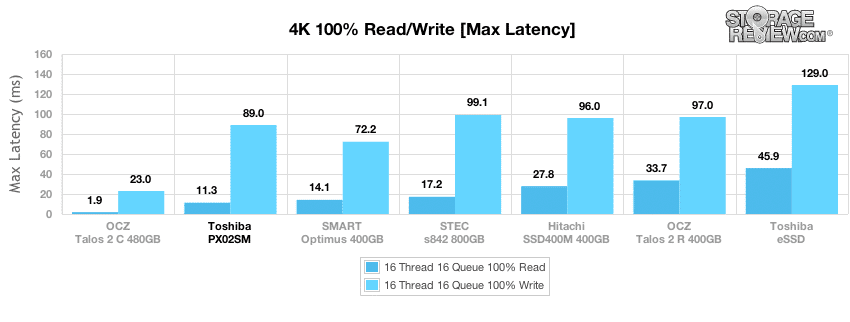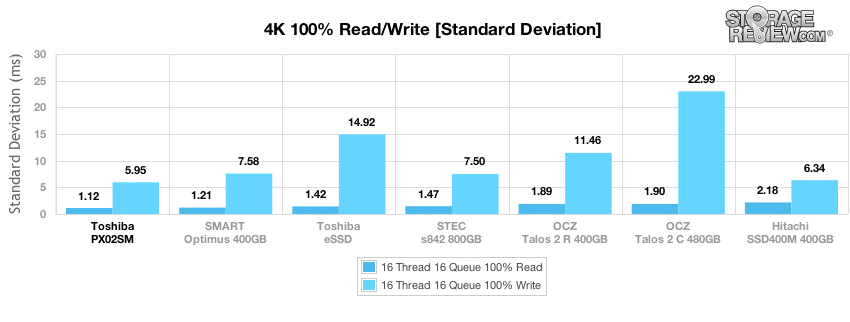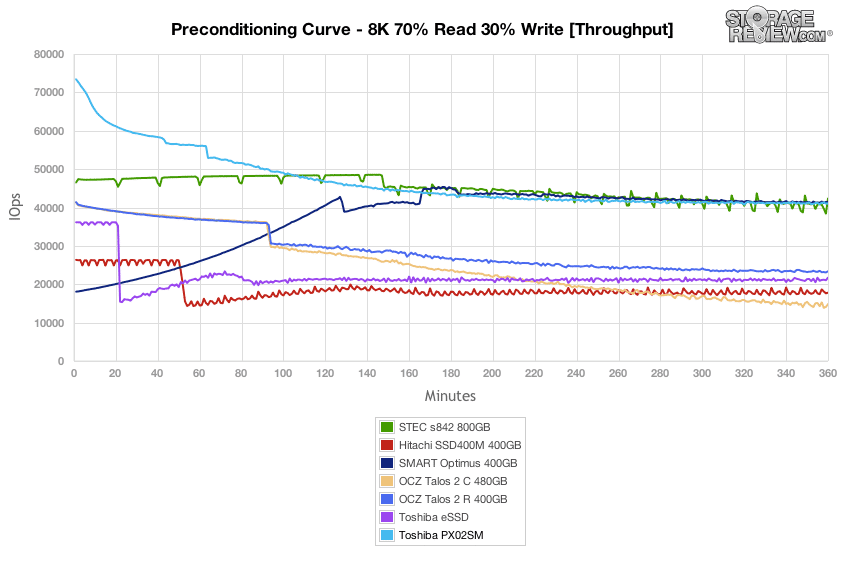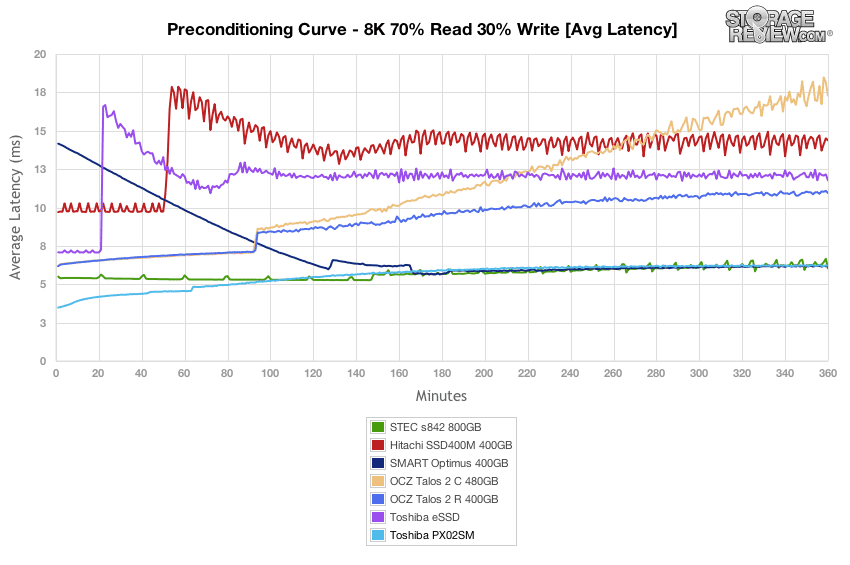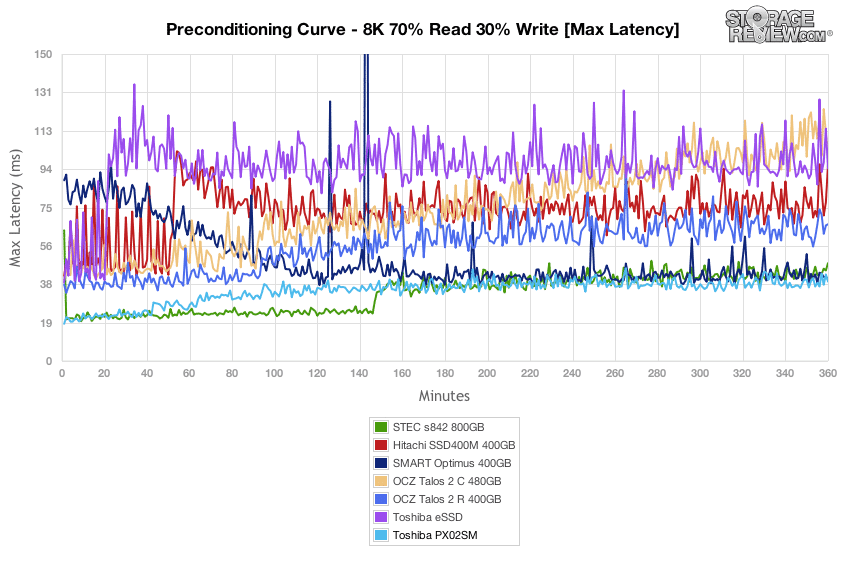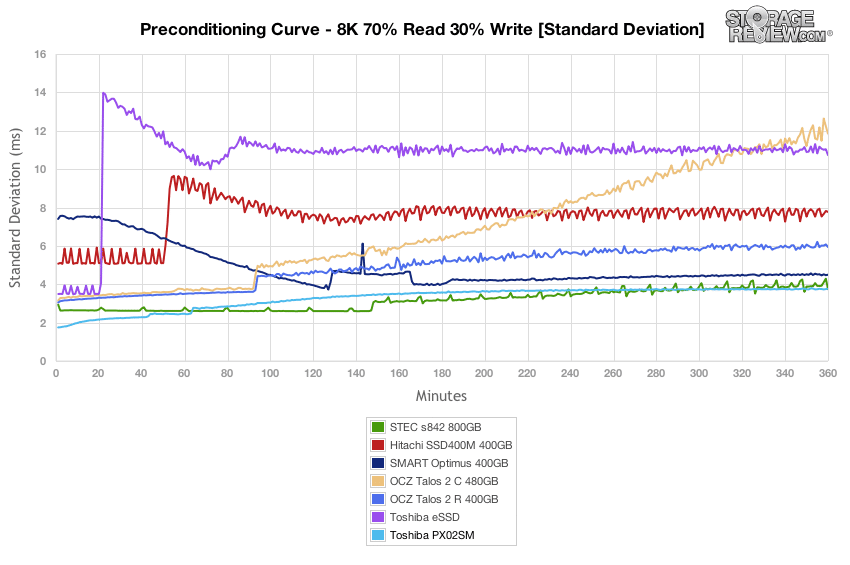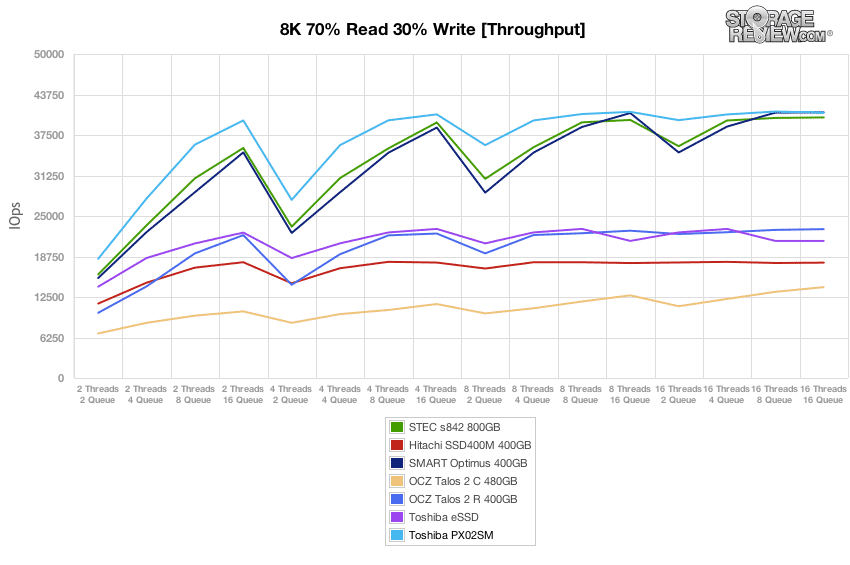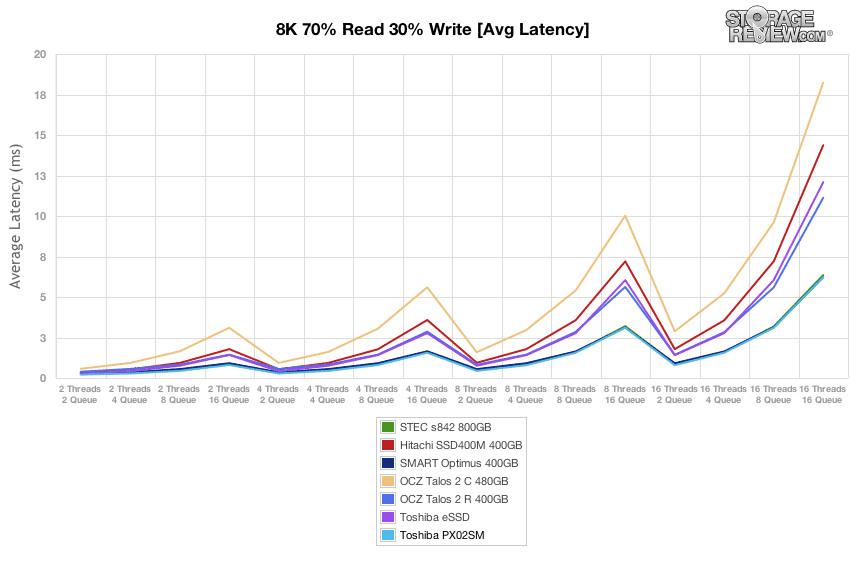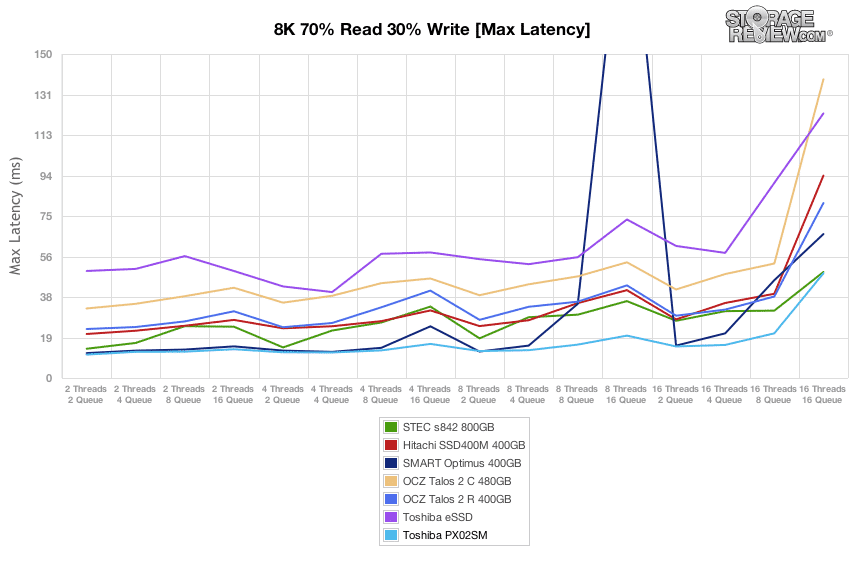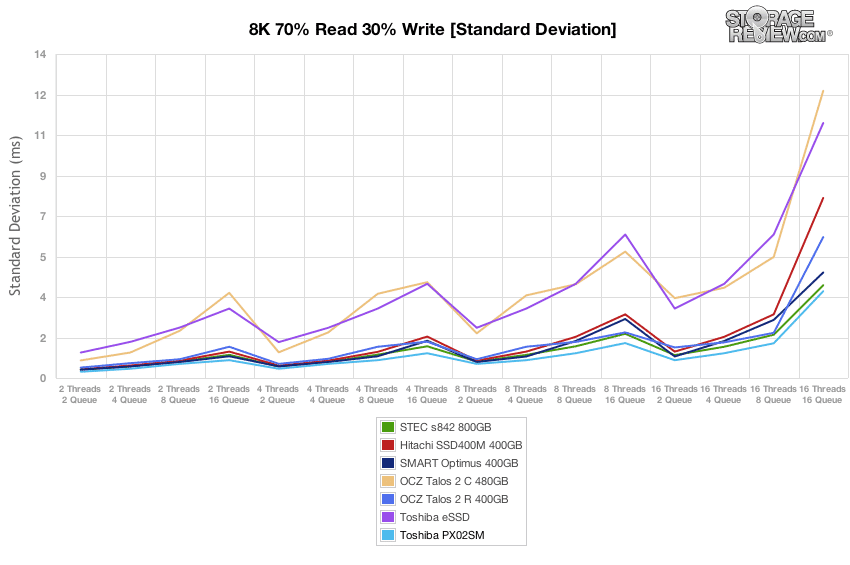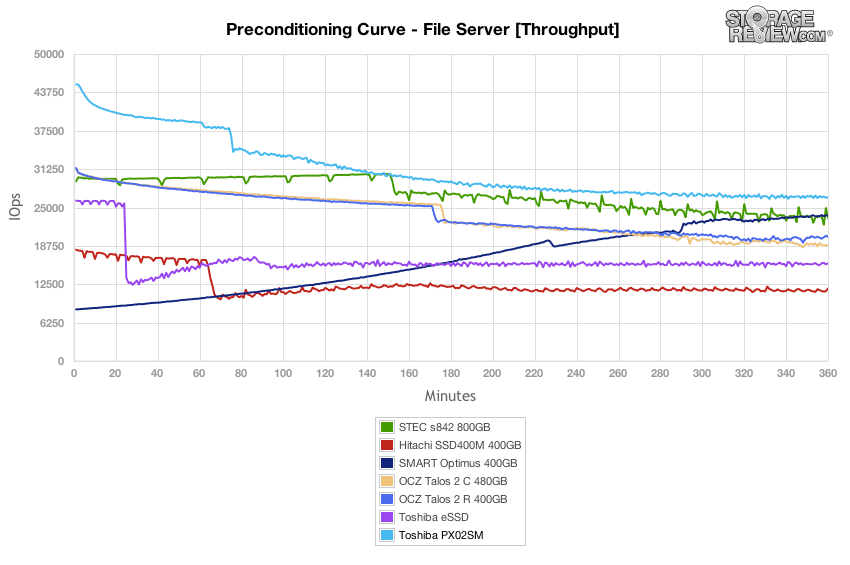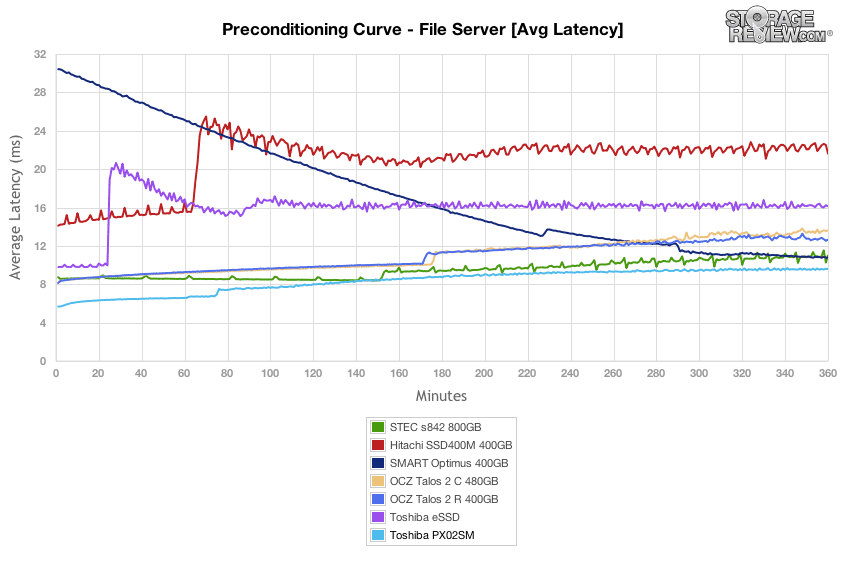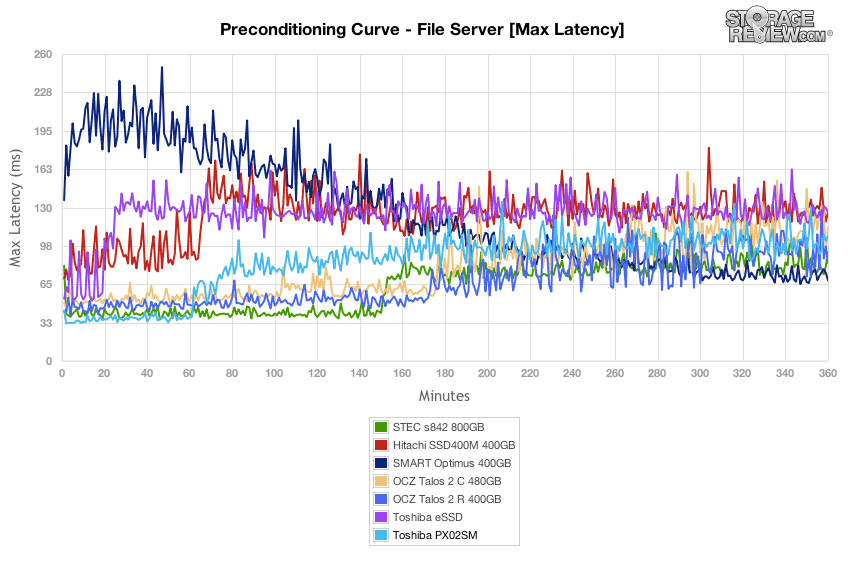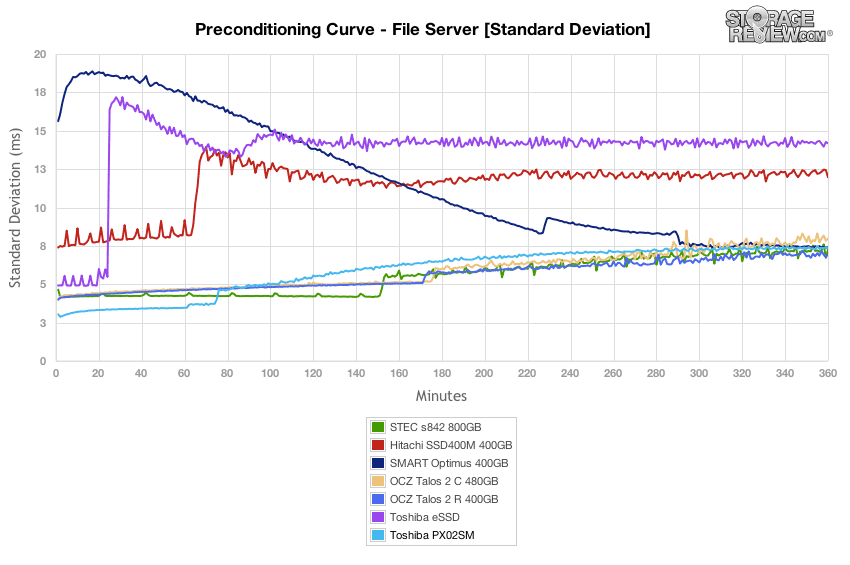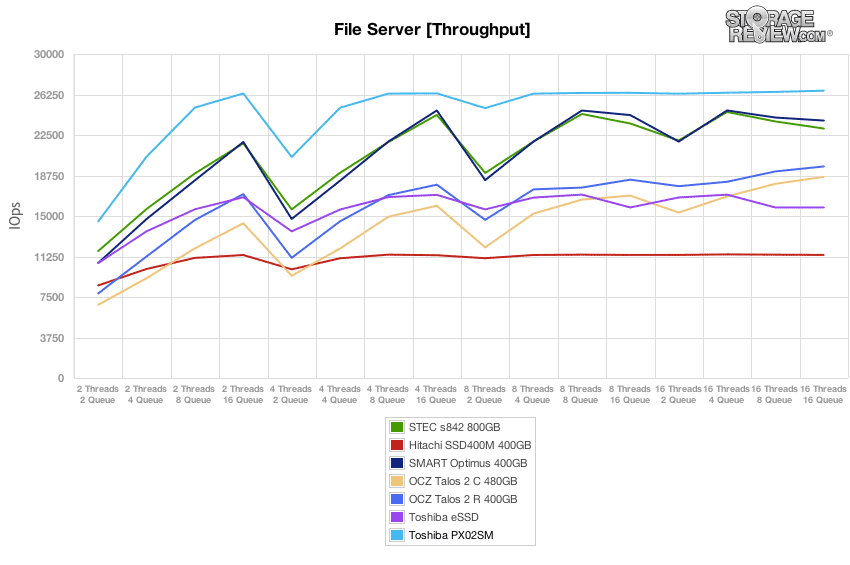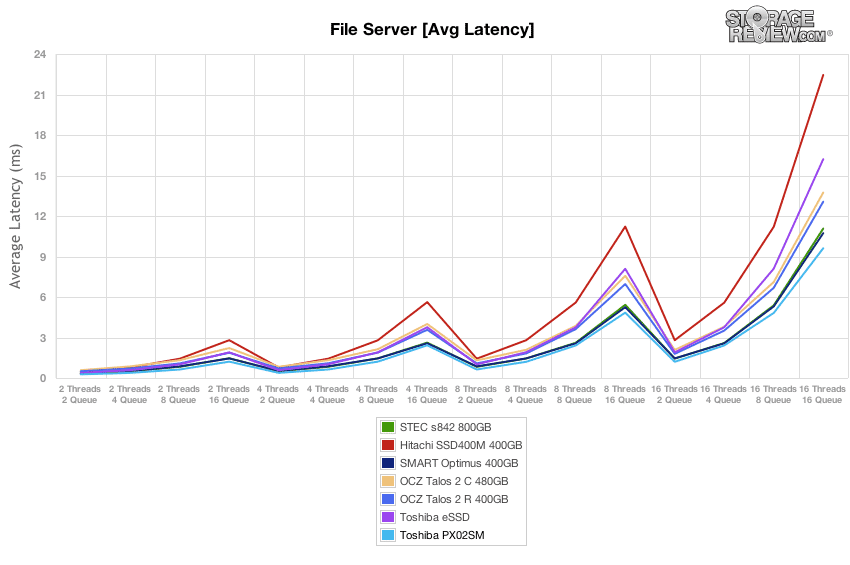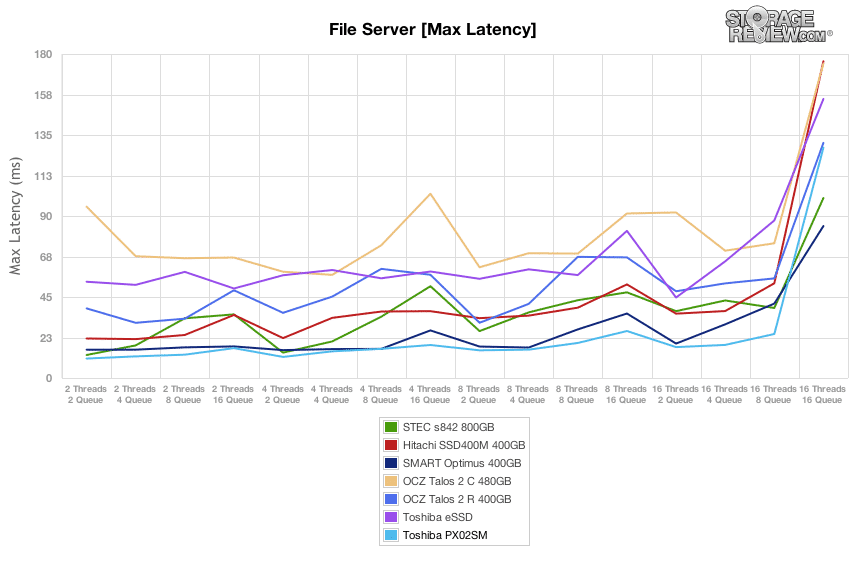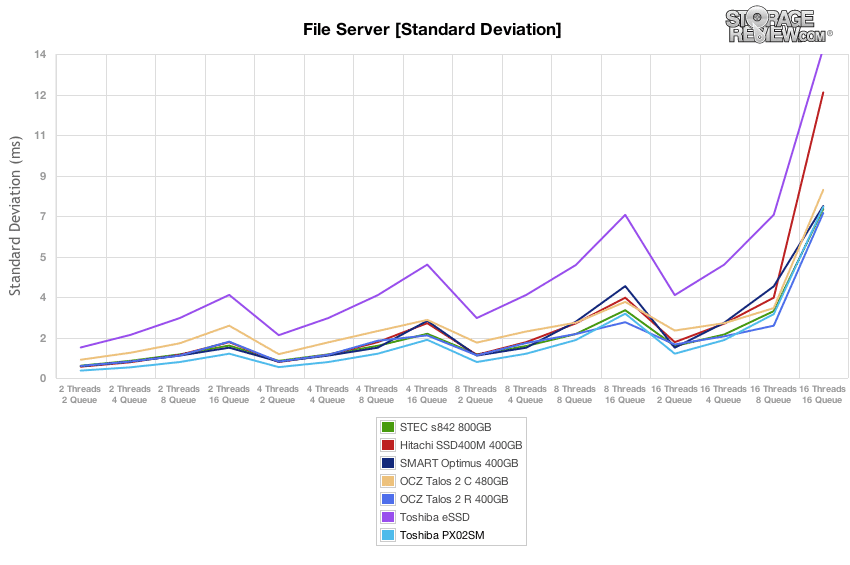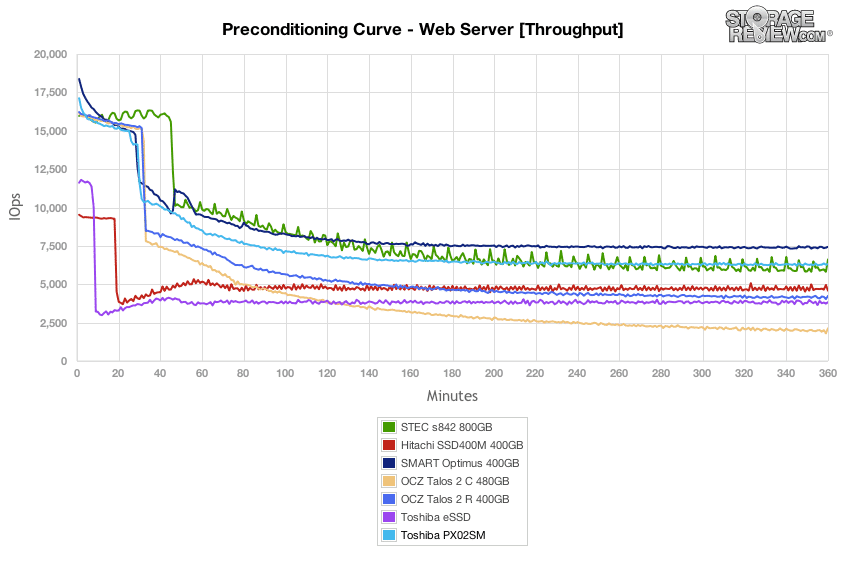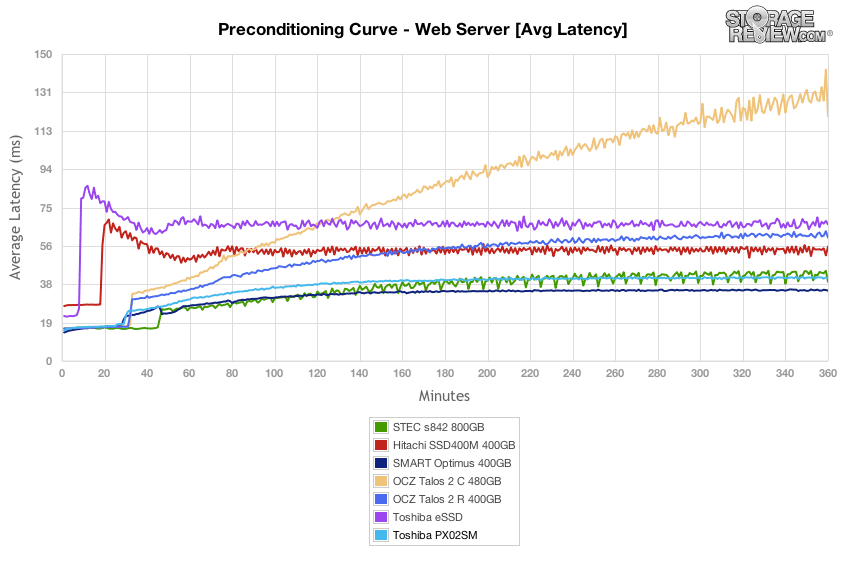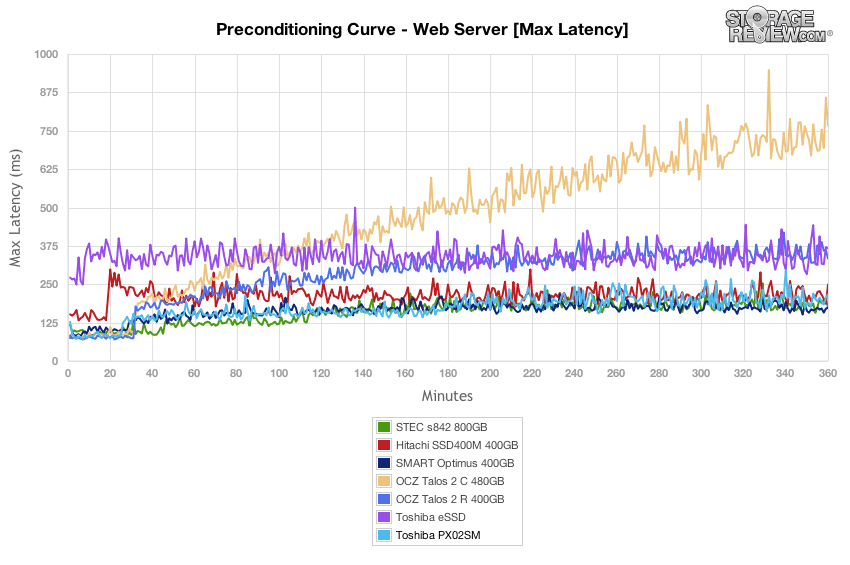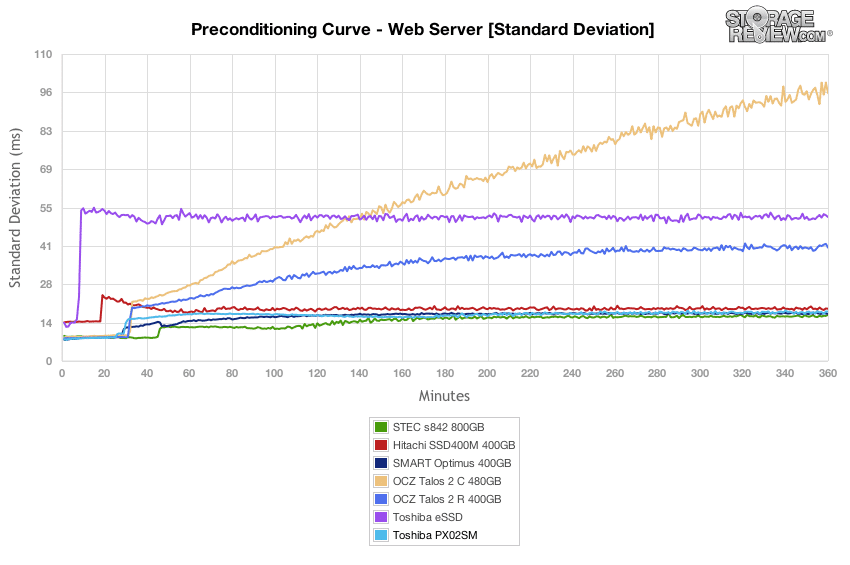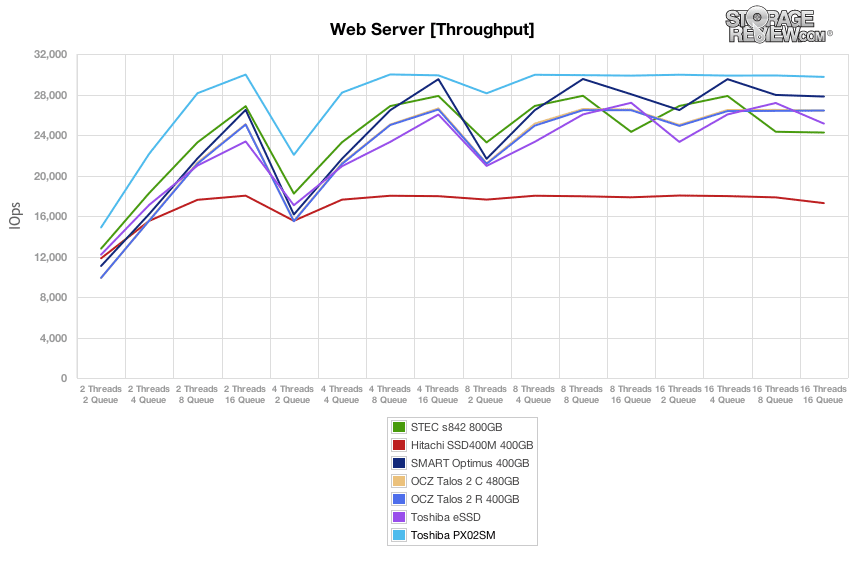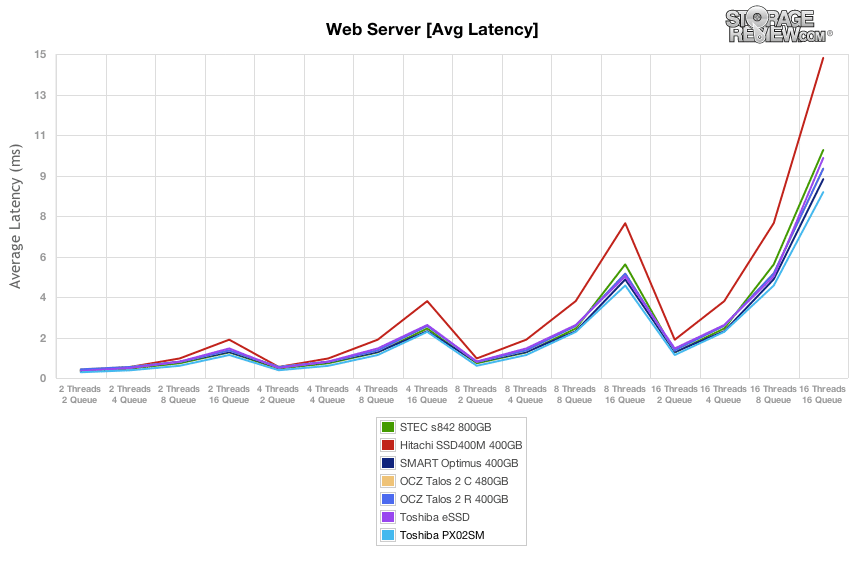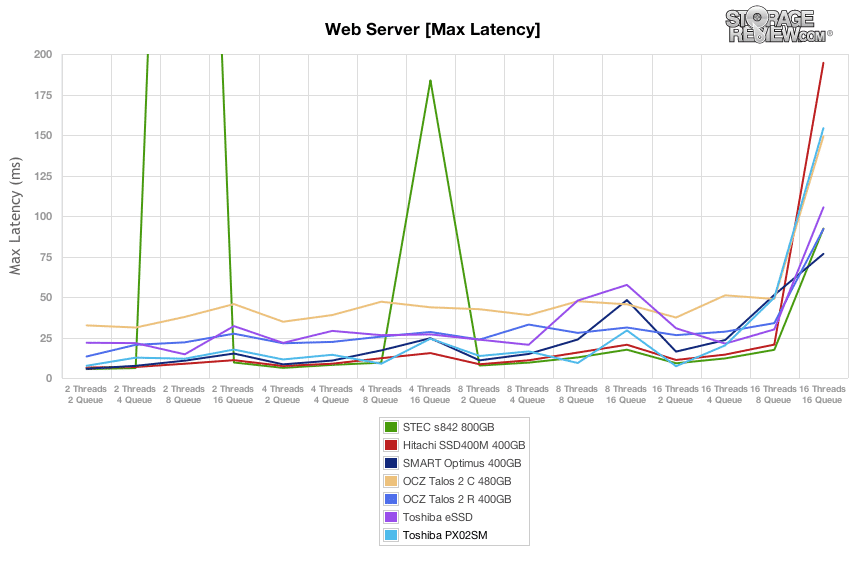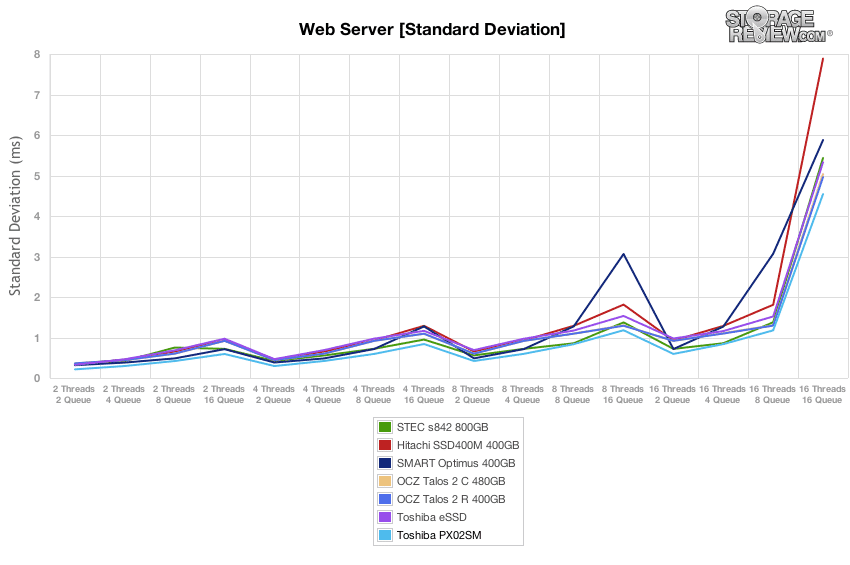
Toshiba’s PX02SM is a high performance enterprise-class SSD that features eMLC NAND with capacities up to 1.6TB as well as a new dual port SAS 12Gb/s interface. The PX02SM updates the Toshiba MKx001GRZB Enterprise SSD that we reviewed which was previously Toshiba’s pinnacle enterprise SSD with 32nm SLC NAND and SAS 6Gb/s in a 2.5", 15mm form factor. This time however, the Toshiba PX02SM comes to market in a 2.5" form factor that has been slimmed down from 15mm to just 7mm (still 15mm for the 1.6TB model). Additionally, Toshiba has chosen to implement eMLC NAND, attaining comparable endurance and even greater cost-effectiveness, yielding lower prices for organizations’ IT budgets.
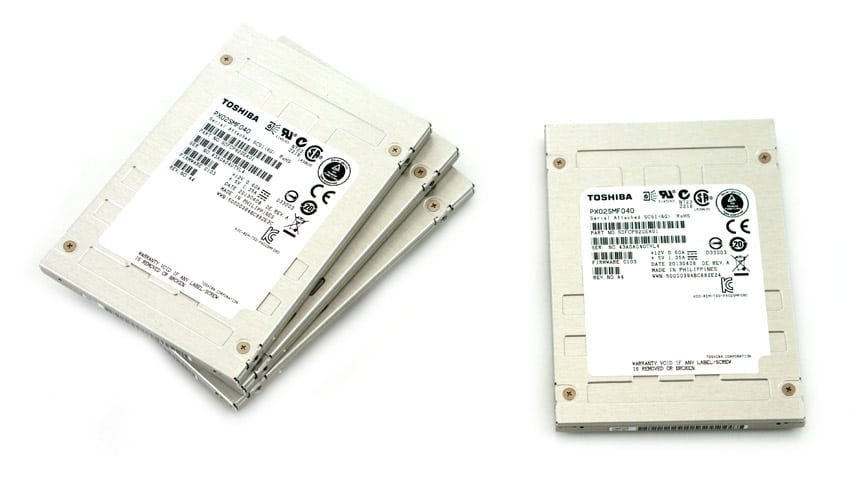
Toshiba’s PX02SM is part of the new PX-series that includes the PX02SM, PX02AM, and PX03AN drives which range in price and performance, though all offer power-loss protection. The PX02SM is the highest-end drive with the greatest performance specs and features layered ECC for enhanced error correction as well as security models with cryptographic erase for improved security. The PX02AM is differentiated by offering mostly the same features, but with a SAS 6Gb/s interface. Rounding out the line, the PX03AN is driven toward the entry enterprise market and comes with 19nm MLC NAND for greater cost efficiency.
For the first time in the industry, we are also seeing a unique SAS 12Gb/s interface with the PX02SM that others in the space have announced, but to this point only Toshiba is shipping. In doing so, Toshiba is getting out ahead of the curve as SAS 12Gb/s HBAs are yet to hit the market. Moving forward, servers that support the new interface should see a considerable boost in performance in their sequential workload read and write activity. At the same time, while server support is still limited for SAS 12Gb/s, the Toshiba PX02SM is of course backwards compatible with SAS 6Gb/s and will provide plenty of throughput via that interface. Organizations that employ the drives and don’t currently own servers that support SAS 12Gb/s will later see performance increases if they upgrade their servers down the road.
The Toshiba PX02SM is available in 200GB, 400GB, 800GB and 1.6TB capacities backed by a five-year limited warranty. Our review model is the 400GB capacity.
Toshiba PX02SM Specifications
- Capacities
- 200GB (PX02SMF020, PX02SMU020)
- 400GB (PX02SMF040, PX02SMU040)
- 800GB (PX02SMF080, PX02SMU080)
- 1.6TB (PX02SMB160, PX02SMQ160)
- NAND: 24nm eMLC
- Interface: SAS 6Gb/s and 12Gb/s
- Form Factor: 2.5” SFF x 7mm High (15mm for 1.6TB model)
- Performance
- Sequential Read (Sustained): 900MB/s
- Sequential Write (Sustained): 400MB/s
- Random Read 4k (IOPS): 120,000
- Random Write 4k (IOPS): 30,000
- Environmental
- Temp – Operating 0° to 55°C
- Temp – Non-Operating -40° to 70°C (-40° to 158°F)
- Vibration – Operating 9.8 m/s² (1G)
- Vibration – Non-Operating 49 m/s² (5G)
- Shock – Operating 9,800 m/s² (1,000G 0.5ms, ½ sine)
- Shock – Non-Operating 9,800 m/s² (1,000G 0.5ms, ½ sine)
- Power Loss Protection
- Endurance TBW: 3.7PB (200GB), 7.3PB (400GB), 14.6PB (800GB), 29.2PB (1.6TB)
- MTTF: 2 Million Hours
- Dimensions (WxDxH): 69.85 mm x 100 mm x 7.0 mm
- Weight: 70g
- 5-year Limited Warranty
Video Overview
Design and Build
While many other drives in the high-performance enterprise SSD space use a 15mm form factor, the Toshiba PX02SM comes in at a slim 7mm (though 15mm for the 1.6TB model) and in a 2.5" form factor. The drive’s exterior is functional, not flashy, and it feels sturdy enough for any application. Toshiba uses a stamped aluminum body versus forged in their previous model, which reduces the bulk and enables Toshiba to more easily hit the 7mm z-height.
On the front of the PX02SM SSD is the industry-standard SAS connection for power and data, which is backwards compatible with SAS 6Gb/s and forward-compatible with SAS 12Gb/s.
Inside, there is a Marvell co-branded TC58NC9036GTC SAS 12Gb/s compatible controller. Our 400GB review model also has 16 24nm eMLC Toshiba NAND die packages, which each have a capacity of 32 GB. This gives the drive a raw capacity of 512GB and an unformatted capacity of 400GB.
Testing Background and Comparables
The Toshiba PX02SM uses a Marvell co-branded TC58NC9036GTC controller and 24nm eMLC NAND with an interface that supports SAS 12Gb/s. However SAS 12Gb/s HBAs aren’t generally available or matured in the market. As such, we are testing the PX02SM over our stabilized SAS 6Gb/s for primary benchmarks with an upcoming article covering early SAS 12Gb/s performance.
Comparables for this review:
- Toshiba MKx001GRZB eSSD (400GB, Marvell 88SS9032-BLN2, Toshiba 32nm SLC NAND, 6.0Gb/s SAS)
- OCZ Talos 2 C (480GB, SandForce SF-2282 controller, Intel 25nm MLC NAND, 6.0Gb/s SAS)
- OCZ Talos 2 R (400GB, SandForce SF-2500 controller, Intel 25nm MLC NAND, 6.0Gb/s SAS)
- Hitachi SSD400M (400GB, Intel EW29AA31AA1 controller, Intel 25nm eMLC NAND, 6.0Gb/s SAS)
- Smart Optimus (400GB, third-party controller, Toshiba 34nm MLC NAND, 6.0Gb/s SAS)
- STEC s842 (s840 series) (800GB, STEC 24950-15555-XC1 controller, Toshiba MLC NAND, 6.0Gb/s SAS)
All SAS/SATA enterprise SSDs are benchmarked on our second-generation enterprise testing platform based on a Lenovo ThinkServer RD630. This new Linux-based testing platform includes the latest interconnect hardware such as the LSI 9207-8i HBA as well as I/O scheduling optimizations geared towards best-case flash performance. For synthetic benchmarks, we utilize FIO version 2.0.10 for Linux and version 2.0.12.2 for Windows.
- 2 x Intel Xeon E5-2620 (2.0GHz, 15MB Cache, 6-cores)
- Intel C602 Chipset
- Memory – 16GB (2 x 8GB) 1333Mhz DDR3 Registered RDIMMs
- Windows Server 2008 R2 SP1 64-bit, Windows Server 2012 Standard, CentOS 6.3 64-Bit
- 100GB Micron RealSSD P400e Boot SSD
- LSI 9211-4i SAS/SATA 6.0Gb/s HBA (For boot SSDs)
- LSI 9207-8i SAS/SATA 6.0Gb/s HBA (For benchmarking SSDs or HDDs)
- Mellanox ConnectX-3 10GbE PCIe 3.0 Adapter
- Mellanox ConnectX-3 InfiniBand PCIe 3.0 Adapter
Application Performance Analysis
In the enterprise market there is a huge difference between how products claim to perform on paper and how they perform in a production environment. We understand the importance of evaluating storage as a component of larger systems, most importantly how responsive storage is when interacting with key enterprise applications. To this end, we’ve rolled out our first application tests including our proprietary MarkLogic NoSQL Database Storage Benchmark and MySQL performance via SysBench.
In our MarkLogic NoSQL Database environment, we test groups of four SATA or SAS SSDs with a usable capacity greater than or equal to 200GB. Our NoSQL database requires roughly 650GB of free space to work with, evenly divided between four database nodes. In our testing environment, we use an SCST host and present each individual SSD in JBOD, with one allocated per database node. The test repeats itself over 24 intervals, requiring between 30-36 hours total for the SSDs in this category. Measuring the internal latencies seen by the MarkLogic software, we record both total average latency, as well as interval latency for each SSD.
In our overall average latency ranking of our MarkLogic NoSQL database benchmark, the Toshiba PX02SM trailed the pack with a response time of 3.538ms versus 2.5-2.6ms from the Hitachi SSD400M and OCZ Talos 2 R and 1.692ms from the Smart Optimus that led the pack.
The Smart Optimus offered the lowest latency in the MLC SAS group, with peaks ranging in the 6-11ms range.
The 400GB Hitachi SSD400M came in next in our MarkLogic latency measurements, with higher latency peaks measuring between 10-25ms, with the bulk coming from journal write latency.
The OCZ Talos 2 R closely trailed the SSD400M, with its peak latency measuring between 9-32ms and its highest peaks coming from merge write activities.
The Toshiba PX02SM SSD came in last in our MLC SAS MarkLogic performance group, with peak latency ranging from 10-30ms and the bulk coming from higher journal write latency.
Our next application test consists of Percona MySQL database test via SysBench, which measures the performance of OLTP activity. In this testing configuration, we use a group of Lenovo ThinkServer RD630s and load a database environment onto a single SATA, SAS or PCIe drive. This test measures average TPS (Transactions Per Second), average latency, as well as average 99th percentile latency over a range of 2 to 32 threads.
In our SysBench tests, the Toshiba PX02SM came in at the top of the pack, with average TPS scaling from 215 TPS at 2 threads to 1487 TPS at 32 threads.
Average latency from the Toshiba PX02SM in SysBench scaled from 9.2ms at 2 threads to 21.52ms at 32 threads.
Comparing 99th percentile latency in our SysBench test, the Toshiba PX02SM came in towards the bottom of the pack, with the highest midrange latency, although coming in slightly ahead of the STEC s842 and Hitachi SSD400M at 32 threads.
Enterprise Synthetic Workload Analysis
Flash performance varies throughout the preconditioning phase of each storage device. Our enterprise storage benchmark process begins with an analysis of the way the drive performs during a thorough preconditioning phase. Each of the comparable drives are secure erased using the vendor’s tools, preconditioned into steady-state with the same workload the device will be tested with under a heavy load of 16 threads with an outstanding queue of 16 per thread, and then tested in set intervals in multiple thread/queue depth profiles to show performance under light and heavy usage.
Preconditioning and Primary Steady-State Tests:
- Throughput (Read+Write IOPS Aggregate)
- Average Latency (Read+Write Latency Averaged Together)
- Max Latency (Peak Read or Write Latency)
- Latency Standard Deviation (Read+Write Standard Deviation Averaged Together)
Our Enterprise Synthetic Workload Analysis includes four profiles based on real-world tasks. These profiles have been developed to make it easier to compare to our past benchmarks as well as widely-published values such as max 4k read and write speed and 8k 70/30, which is commonly used for enterprise drives. We also included two legacy mixed workloads, the traditional File Server and Webserver, each offering a wide mix of transfer sizes.
- 4k
- 100% Read or 100% Write
- 100% 4k
- 8k 70/30
- 70% Read, 30% Write
- 100% 8k
- File Server
- 80% Read, 20% Write
- 10% 512b, 5% 1k, 5% 2k, 60% 4k, 2% 8k, 4% 16k, 4% 32k, 10% 64k
- Webserver
- 100% Read
- 22% 512b, 15% 1k, 8% 2k, 23% 4k, 15% 8k, 2% 16k, 6% 32k, 7% 64k, 1% 128k, 1% 512k
Our first test measures 100% 4k random write performance with a load of 16T/16Q. In this test, the Toshiba PX02SM tested at 50,500 IOPS in burst performance, which then leveled off around 28,500 IOPS as the drive neared steady-state. Both figures were second best in the group.
With a heavy 16T/16Q load, the Toshiba PX02SM measured 5.05ms in burst and scaled up to right around 9ms as it neared steady-state. While the PX02SM started in the lead briefly, it was later edged out by the Smart Optimus.
Comparing max latency between the SSDs, the Toshiba PX02SM had max response times ranging 60-90ms in steady-state – a range that is positioned near the better figures of the drives in the group.
Looking even closer at the latency consistency in our 4k random write workload, the Toshiba PX02SM placed first around only 6ms.
After 6 hours of preconditioning, the Toshiba PX02SM offered 4k random read performance at a blistering 112,479 IOPS and write speed at 28,438 IOPS.
With a workload of 16T/16Q, the Toshiba PX02SM offered an average 4k random read latency of 2.27ms, with a write latency of 9ms even.
Max latency from the Toshiba PX02SM was second best for read activity at 11.3ms behind the OCZ Talos 2 C, and its write activity number was 89ms, good enough for third in the group.
Comparing latency consistency, the Toshiba PX02SM posted the strongest figures in 4k random read and write consistency.
In our next workload we look at an 8k profile with a 70/30 read/write mixed ratio. In this setting, the Toshiba PX02SM started off around 73,400 IOPS burst which slowed to a speed around 41,100 IOPS near steady-state. The burst performance was far ahead of the competition, while the steady-state speed was still as high as most drives’ burst speeds.
Average latency of the Toshiba PX02SM measured 3.48ms at the beginning of our 8K 70/30 preconditioning test, which increased to around 6.25ms as it neared steady-state. That kept right in line with the STEC s842 and Smart Optimus drives that led the way.
Over the duration of our 8k 70/30 test, the Toshiba PX02SM offered the best peak response times, with max latency measuring below 40ms for the duration of the test.
The Toshiba PX02SM’s latency consistency crisscrossed with the STEC s842, though it was able to achieve the lowest mark at the final stages.
Compared to the fixed 16 thread, 16 queue max workload we performed in the 100% 4k write test, our mixed workload profiles scale the performance across a wide range of thread/queue combinations. In these tests, we span workload intensity from 2 threads and 2 queue up to 16 threads and 16 queue. In the expanded 8k 70/30 test, the Toshiba PX02SM peaked at 41,122 IOPS which was at the top of the group along with the STEC s842 and the Smart Optimus.
Average latency for the Toshiba PX02SM was quite good, staying right in line with the other leading drives, the STEC s842 and Smart Optimus.
Over the duration of our varying load 8k 70/30 test, max latency stayed very low with the Toshiba PX02SM with the peak staying under 20ms for the bulk of the test until 16T8Q. It jumped slightly to around 40ms with the highest 16T/16Q load, which was still the lowest peak amongst the SSDs.
Standard deviation from the Toshiba PX02SM in our test environment was class-best, peaking just a bit lower than the STEC s842 and Smart Optimus.
The next workload is our File Server profile, which covers a wide range of transfer sizes spanning from 512b to 512K. With a heavy 16T/16Q saturation load, the Toshiba PX02SM offered the highest peak by over 10,000 IOPS and best steady-state performance, though the STEC s842 and Smart Optimus caught up to make it closer.
Average latency in the preconditioning section of our File Server test for the Toshiba PX02SM measured around 5-7ms during burst speeds and slowly increased to 8-9ms over the duration of the test.
The Toshiba PX02SM offered max latency in our File Server preconditioning section around 40-50ms during burst conditions and predominantly remained under 120ms as it neared steady-state. The burst and steady-state figures placed it near the middle of the group.
In terms of latency consistency, the Toshiba PX02SM offered solid performance in our File Server test, coming in near the top of the group.
After each drive completed the preconditioning stage, we dropped into a varying workload where we scaled the thread and queue count from 2T/2Q up to 16T/16Q. The Toshiba PX02SM performed at the top of group throughout the test, ending in the same position at the 16T/16Q load.
The OCZ Talos 2 R offered average latency that ranked at the front of the group peaking at just over 9ms.
The max latency of the Toshiba PX02SM in our File Server test stayed below 25ms for all loads below 16T/16Q, and then increased sharply to 128ms to end in the middle of the group.
The Toshiba PX02SM’s standard deviation was highly consistent, remaining close to the pack of SSDs.
Our final preconditioning workload takes the traditional 100% read activity Web Server test and flips it to 100% write to precondition each SSD. This is our most aggressive workload, although it doesn’t really match any real-world conditions with 100% write. In this section, the Toshiba PX02SM started with the second highest burst at 17,127 IOPS, before it tapered off to 6,299 IOPS, comparable to the STEC s842, but below the Smart Optimus.
The Toshiba PX02SM started with a low response time and finished with it too. It again matched closely to the STEC s842, with the Smart Optimus again taking top honors.
The Toshiba PX02SM started off well and again finished well coming very close to the STEC s842 and Smart Optimus in max latency.
Coordinating well with what we had seen in the other Web Server tests to this point, the Toshiba PX02SM maintained solid figures that matched up closely to the STEC s842 and Smart Optimus in steady-state.
After each SSD finished our preconditioning stage in the Web Server test, we flipped the workload back to 100% read. In read-only conditions, the Toshiba PX02SM again consistently offered the highest throughput in all the thread/queue loads. It peaked around 29,700 IOPS at the highest effective queue depth.
Average response times from the Toshiba PX02SM were low throughout the queue depths, and at 8.5ms, they were good enough to narrowly edge out the competition.
Comparing max latency, the Toshiba PX02SM registered response times measuring 10-20ms over the bulk of the test. However, the PX02SM finally finished below the middle of the group peaking at 154ms at the 16T/16Q load.
In terms of latency consistency in our read-only Web Server workload, the Toshiba PX02SM started out at the top of the group in performance by a small margin, and as the test progressed, the PX02SM continued to mark the best performance.
Conclusion
Toshiba’s highest performance enterprise SSD is the PX02SM, the first SSD to ship with SAS 12GB/s interface. The PX02SM also features capacities that range up to 1.6TB as well as eMLC NAND to reduce costs while maintaining higher-end enterprise endurance. Another standard feature on the PX02SM is power-loss protection which protects in-flight data in the event of an unexpected loss of power. Toshiba also implemented some engineering feats in the PX02SM to reduce the size from their previous generation which was 15mm down to an increasingly popular slim 7mm drive height (except for the 1.6TB drive that remains at 15mm).
Toshiba’s first major claim with the PX02SM will be that though others have announced SAS 12Gb/s products, Toshiba is now first to market with their SSD. It’s very important to note that we tested the Toshiba PX02SM over SAS 6Gb/s since 12Gb/s SAS HBAs haven’t had a chance to mature in the enterprise market (and haven’t begun shipping in channel), and early samples won’t be seen in any production environments until much later this year or next. That means sequential workload figures should be impressive for future servers that support SAS 12Gb/s, although mixed workload performance that is limited by the drive’s controller won’t see big gains since that still falls well within the capabilities of existing SAS 6Gb/s platforms.
Our testing showed that the SSD consistently outperformed the comparable drives in synthetic benchmarks. The Toshiba PX02SM produced very high throughput in burst, and its steady-state figures were often in line with the comparable drives’ burst speeds. Further, the PX02SM maintained very low latency throughout testing. While the STEC s842 and Smart Optimus SSDs were typically able to keep relative pace, more often than not the Toshiba PX02SM came out on top of the competition. This is particularly applicable in the 4k and 8k workloads, though the gap was narrowed in our FileServer and WebServer profiles.
While synthetic benchmark performance can be good to rank drives under clean conditions, the dynamic changes drastically when you put those same devices in real-world applications. A big surprise for us is that while the drive performed quite well in synthetic benchmarks, it still fell behind the competition in our MarkLogic NoSQL environment, testing with twice the latency of the MLC-group leader, the Smart Optimus. Looking at traditional database performance in our SysBench environment that leverages OLTP performance of a MySQL instance, the PX02SM lead the pack by a small margin, although with 99th percentile latency that slipped behind others in the group.
Pros
- First to market with SAS 12Gb/s
- Offers the highest performance in synthetic workloads
- Excellent SysBench MySQL performance
Cons
- Weak MarkLogic NoSQL database performance
Bottom Line
The Toshiba PX02SM is an innovative SSD that is the first SSD to ship that utilizes SAS 12Gb/s interface, though with HBAs not shipping to market for a few months, organizations will have to wait to benefit from the full performance gains. In our testing, the drive performed very well in clean synthetic tests and in the MySQL environment, but did not fare as well with NoSQL.

